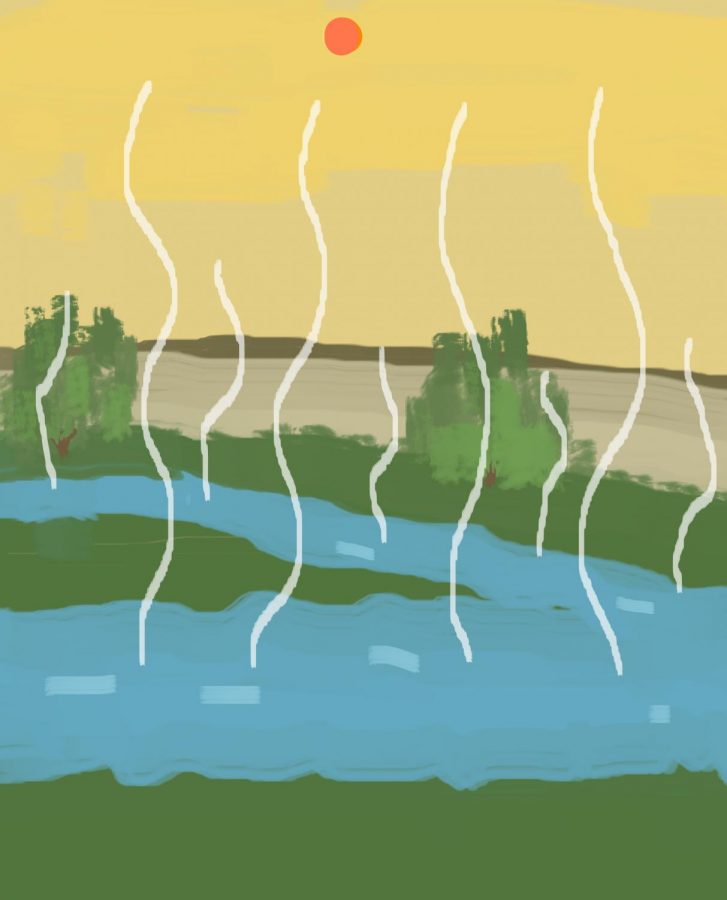High river temperatures dangerous to salmon
Rising water temperatures caused by climate change, deforestation, dams, removal of vegetation along rivers
Salmon and most other fish do not internally regulate their temperatures. Instead, they adapt to water temperatures, so if the water is too hot or cold, the fish will not survive.
June 7, 2020
The Environmental Protection Agency released a report May 18 for public comment stating the temperatures of the Columbia and Lower Snake rivers do not meet Washington’s and Oregon’s water quality standards, which can be harmful to salmon.
The report creates a temperature standard for the Lower Columbia and Lower Snake rivers in Washington and Oregon. The report states it is challenging to establish standards because of the many factors that influence the rivers’ water temperatures, said Sarah Highfield, communications director for the Port of Whitman County.
The states’ water quality standards for some areas of these rivers are not being met, according to the EPA report, because the temperature is too hot.
The report established maximum temperatures for the rivers. These temperatures can only be exceeded a certain number of times over a certain time period, said Jenifer McIntyre, assistant professor for WSU’s School of the Environment. This has been created so the rivers can be in compliance with the states’ water quality standards and aquatic animals can be kept safe.
“The trouble with these warmer temperatures tends to be this vulnerability to disease, especially for the returning adults [salmon] because they’re already stressed out trying to swim upstream,” McIntyre said.
Salmon and most other fish do not internally regulate their temperatures, so their body temperatures are the temperature of the water they are swimming in, she said.
When salmon are in their optimal temperature range, they can grow and reproduce properly, McIntyre said, but outside of that range becomes more difficult. If the water temperature is too hot or too cold, it can be lethal to salmon. However, higher temperatures are especially bad for them.
Different salmon species have different optimal temperature ranges. The lethal range is in the low- to mid-20s degrees Celsius, McIntyre said. For some salmon species, anything above 18 degrees Celsius might be too warm for extended periods of time.
The salmon, through their migration from freshwater to the Pacific Ocean and back, are important to many ecosystems. Many different animal species feed on salmon carcasses, and the nutrients in the salmon carcasses left in forests then decompose, she said.
Climate change, deforestation, dams and the removal of vegetation along rivers contribute to the rising temperatures of the rivers, she said.
Dams create something akin to a pool of water instead of running water. The water is still running, but it is much slower than it would be without a dam, McIntyre said. These reservoirs warm up more easily, so the water at the top gets warmer.
Additionally, warm water pours over the barrier of the dam, she said. Dams push the warmest water downstream over the top of the dam.
McIntyre said it is difficult to say whether removing one dam from the Columbia or Lower Snake rivers would make the water temperature cooler. Taking out one dam would probably make a difference, she said, but she does not know how much of a difference it would make.
What the government will do about the warm water is the main issue, said Julian Matthews, board member and coordinator of Nimiipuu Protecting the Environment, a group that educates Nez Perce tribal members on environmental issues.
Matthews said he is worried salmon will go extinct if nothing is done.
“What I’m hoping is that they determine the breaching of those four Lower Snake River dams will help cool the water,” he said.
The EPA report tries to quantify what the river temperatures might be with and without the dams. However, it is hard to figure out what the temperature of the rivers would be without them, Highfield said.
“They do concede that it might be difficult to meet the water quality standards even without the dams,” she said.
The Columbia and Lower Snake river water in Washington and Oregon are already too hot when it enters from Idaho and Canada, Highfield said.
The Port of Whitman County is a member of Northwest RiverPartners, she said.
“[The Port of Whitman County] agree[s] with the Northwest RiverPartners’ initial statement,” Highfield said. “Which is that the water quality standards for Washington and Oregon are unachievable regardless of the dams being in place on the Lower Columbia and the Lower Snake.”
The dams provide benefits to people, including hydropower to the Pacific Northwest and barge transportation, which allows farmers in Whitman County to compete for the international market, Highfield said.
The public comment period ends July 21. More information about how to submit a comment can be found here.










David Moskowitz • Jun 9, 2020 at 12:45 pm
Thanks for the good article.
I would like to highlight a few other issues for your readers.
First, EPA also released a draft report in October 2019 that addresses what are referred to as “cold water refugia” which are sites where a tributary source of colder water enters the Columbia River which – by July – is often above the water quality standard of 68F (20C). EPA’s draft Cold Water Refugia Report identifies 191 tributary sources downstream of the Snake River – of these 23 are defined as being “significant” and 12 of those as “critical” to safe salmon and steelhead migration. The EPA draft plan does not provide for state action to protect these cold-water sources, but makes recommendations. The most “chilling” aspect of the draft report is that EPA estimates that the Columbia River will become a lethal migratory corridor by 2040 if nothing is done to protect the existing cold-water sources.
Second, there is letter from 55 scientific and policy experts that addresses the importance of Snake River Dam removal to improve water quality for salmonids. You can find it here – it is a solid statement of need:
https://www.wildsalmon.org/images/factsheets-and-reports/2019.Sci.Letter.Snake.climate.final.gen.pdf
Keep up the goods work highlighting these issues – both of these reports noted in my comment should help people craft comments to EPA by the July 21 deadline.
Sincerely,
David Moskowitz
The Conservation Angler
Gene Spangrude • Jun 8, 2020 at 9:17 am
The United States Geological Survey (USGS) collected Water Temperatures on the Lower Snake River downstream of Clarkston, Washington; in the early 1950’s; the data was published annually in the following Water Supply Papers:
Love, S.K., U.S. Department of the Interior, Geological Survey, Quality of the Surface Waters of the United States, United States
Geological Survey Water Supply Papers (WSP) #1253 (for Year 1952), WSP #1293 (for Year 1953), WSP #1353 (for Year 1954),
WSP #1403 (for Year 1955), WSP #1453 (for Year 1956), U.S. Government Printing Office, Washington D.C.
During this time (1952-1956), as per the above sources, Lower Snake River water temperatures in excess of 65 degrees Fahrenheit
were recorded on 304 days, which is approximately 17 per cent of the total observations, or about one out of every six made.
Water temperatures in excess of 70 degrees Fahrenheit were noted on 100 days, which is about 5 percent of the total observations,
or about one out of every 20 made.
This was ‘prior to the Lower Snake River Dams’ construction; and thus represents the ‘natural pre-Lower Snake River project conditions’ downstream of Clarkston.